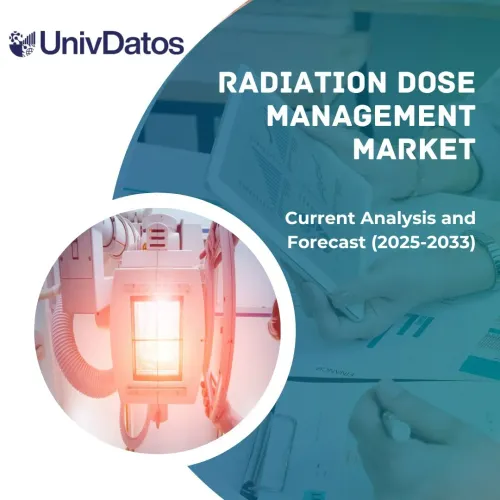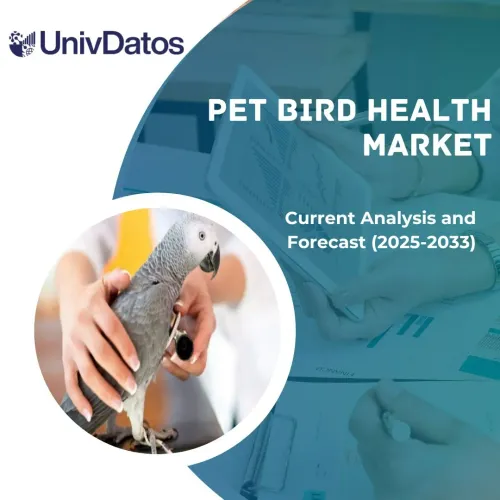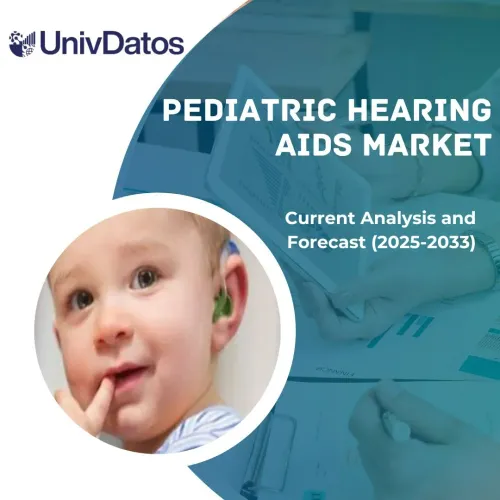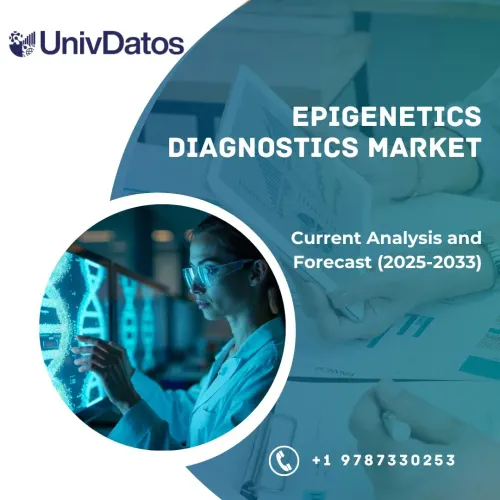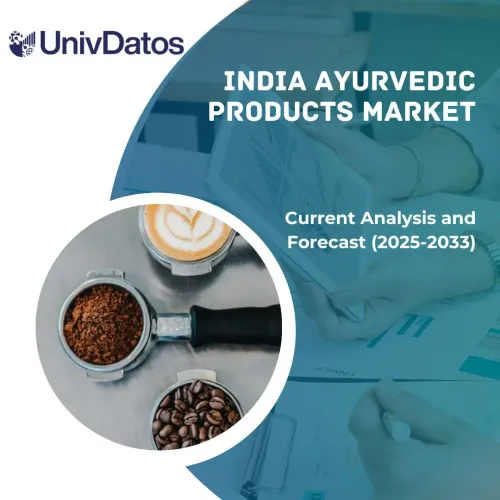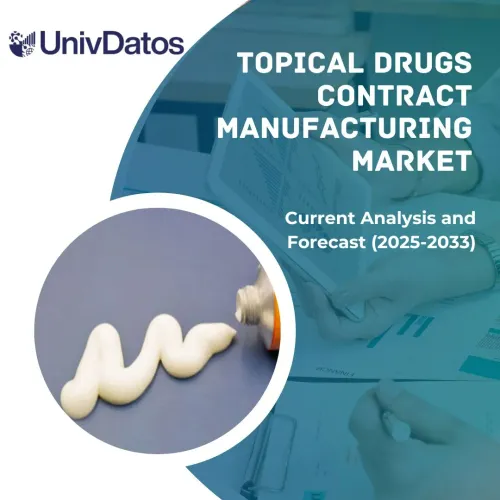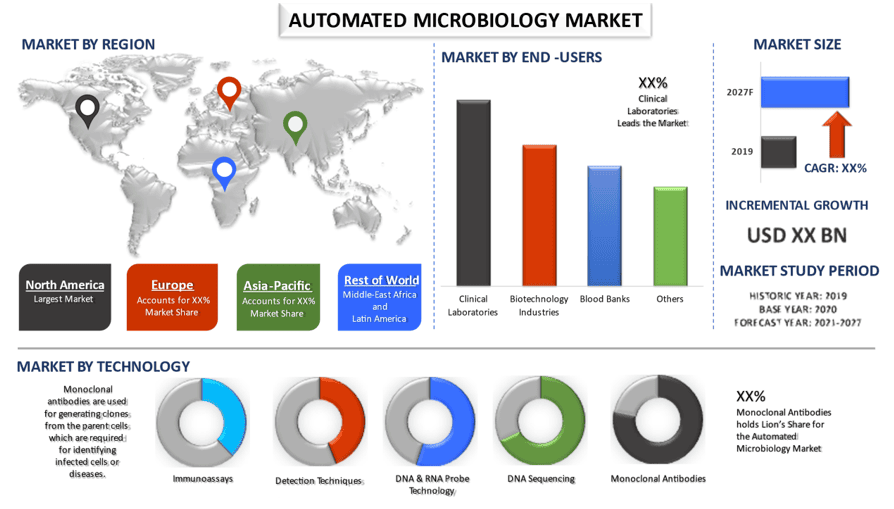
预计全球自动化微生物市场在预测期内(2021-2027)将以约9%的较高复合年增长率增长。自动化微生物学是一种更准确、更快速地提供测试结果的先进方法。这种方法实现了许多关键微生物过程的自动化,例如在各种生物、生态和食品工业中对微生物进行分离、检测、分类和测量。
随着微生物学领域的技术快速发展和技术创新,许多行业参与者都专注于向市场推出新产品,以满足对高质量实验室服务日益增长的需求,因此自动化微生物学市场正在全球范围内出现增长。例如,2021年10月,韩国领先的临床诊断公司GC Labs推出了WASPLab(bioMerieux,法国),这是韩国首个微生物学全实验室自动化系统。该系统自动处理从样品接收到接种、培养和解释的系列步骤,而这些步骤此前都是手动进行的。此外,这些系统能够迅速响应日益增长的公共卫生需求,并提供对疾病和病原体的准确、更好、更快速的识别,这也是推动自动化微生物市场发展的一些突出因素。
2019年选定国家已诊断传染病的患病率
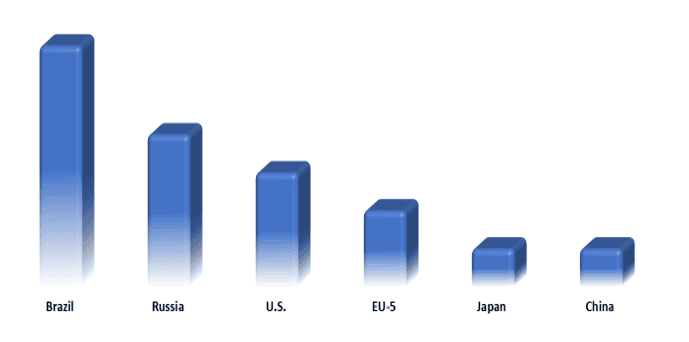
Bio-Rad Laboratories、Becton Dickinson and Company、BioMeriux, Inc.、QIAGEN GmbH、Agilent Technologies、Abbott Laboratories、Affymetrix, Inc.、Gene-Probe, Inc.、Beckman Coulter、Cepheid 是在自动化微生物市场中运营的一些主要参与者。这些参与者已经进行了一些并购以及合作,以帮助客户使用新型自动化微生物系统。
报告中呈现的见解
“在技术方面,单克隆抗体细分市场占据主要份额”
根据技术,自动化微生物市场被细分为DNA测序、DNA和RNA探针技术、检测技术、免疫分析和单克隆抗体。单克隆抗体细分市场在2020年占据了 значительная 的市场份额,预计在预测期内将呈现最高的复合年增长率。该细分市场的增长可归因于单克隆抗体在从母细胞生成克隆方面的日益增长的应用,这些克隆是识别受感染细胞或疾病所必需的。
“在最终用户方面,临床实验室细分市场占据主要份额”
根据最终用户,自动化微生物市场分为生物技术产业、临床实验室、血库和其他。临床实验室细分市场在2020年占据了 значительная 的市场份额,预计在未来几年内将以可观的复合年增长率增长,这归因于在临床实验室中进行的各种微生物研究活动的增加。
“北美洲是自动化微生物市场最大的市场之一”
为了更好地理解自动化微生物市场的市场动态,对全球不同地区进行了详细分析,包括北美(美国、加拿大和北美其他地区)、欧洲(德国、法国、西班牙、英国、意大利和欧洲其他地区)、亚太地区(中国、印度、澳大利亚、日本和亚太其他地区)、世界其他地区。北美是自动化微生物市场行业的主要市场,在2020年创造了数百万美元的收入,这归功于该地区拥有完善的市场参与者。
购买本报告的原因:
- 该研究包括经过权威的行业专家验证的市场规模和预测分析
- 该报告快速概览了整体行业表现
- 该报告涵盖了对主要行业同行的深入分析,主要侧重于关键的业务财务状况、产品组合、扩张战略和近期发展
- 对行业中普遍存在的驱动因素、限制因素、关键趋势和机会的详细考察
- 该研究全面涵盖了不同细分市场的市场
- 对该行业的深度区域级分析
定制选项:
全球自动化微生物市场可根据需求或任何其他细分市场进行进一步定制。此外,UMI了解到您可能拥有自己的业务需求,因此,请随时与我们联系以获取完全符合您要求的报告。
目录
分析历史市场、估算当前市场并预测全球自动化微生物市场的未来市场是创建和分析自动化微生物在主要地区全球范围内应用的主要三个步骤。进行了详尽的二次研究,以收集历史市场数据并估算当前的市场规模。其次,为了验证这些见解,考虑了大量的调查结果和假设。此外,还与全球自动化微生物市场价值链中的行业专家进行了详尽的初步访谈。通过初步访谈对市场数据进行假设和验证后,我们采用了自上而下/自下而上的方法来预测完整的市场规模。此后,采用了市场细分和数据三角测量方法来估算和分析该行业所属细分市场和子细分市场的市场规模。详细的方法如下:
历史市场规模分析
第1步:深入研究二手资料来源:
进行了详细的二次研究,通过公司内部来源(例如)获得自动化微生物的历史市场规模年度报告和财务报表、业绩展示、新闻稿等,以及包括在内的外部来源期刊、新闻和文章、政府出版物、竞争对手出版物、行业报告、第三方数据库和其他可信出版物。
第2步:市场细分:
在获得自动化微生物市场的历史市场规模后,我们进行了详细的二次分析,以收集主要地区不同细分市场和子细分市场的历史市场见解和份额。报告中包含的主要细分市场包括产品和分销渠道。进一步进行了国家级分析,以评估全球范围内自动化微生物的整体应用情况。
第3步:因素分析:
在获得不同细分市场和子细分市场的历史市场规模后,我们进行了详细的因素分析来估算自动化微生物的当前市场规模。此外,我们使用因变量和自变量进行了因素分析,例如实验室研究技术的技术进步以及自动化技术的日益普及。对供需情况进行了彻底的分析,考虑了全球自动化微生物领域的主要合作关系、并购、业务扩张和产品发布。
当前市场规模估算与预测
当前市场规模测算:根据以上3个步骤的可操作见解,我们得出了当前市场规模、自动化微生物市场中的主要参与者以及各细分市场的市场份额。所有所需的百分比份额拆分和市场细分均使用上述二次方法确定,并通过初步访谈进行验证。
估算与预测:对于市场估算和预测,为包括驱动因素和趋势、限制因素以及利益相关者可用的机会在内的不同因素分配了权重。在分析了这些因素之后,应用了相关的预测技术,即自上而下/自下而上的方法,以得出关于2027年全球主要市场不同细分市场和子细分市场的市场预测。用于估算市场规模的研究方法包括:
- 该行业的市场规模(以美元计)以及自动化微生物在主要国内市场的应用率
- 所有市场细分和子细分的百分比份额、拆分和细分
- 自动化微生物市场中按产品提供的关键参与者。此外,这些参与者为争夺快速增长的市场而采取的增长战略
市场规模与份额验证
一级调研:与主要地区的关键意见领袖 (KOL)(包括高管(CXO/副总裁、销售主管、市场营销主管、运营主管和地区主管、国家主管等))进行了深入访谈。然后总结一级调研结果,并进行统计分析以证明既定假设。一级调研的输入与二级调研结果合并,从而将信息转化为可操作的见解。
不同地区一级参与者的细分
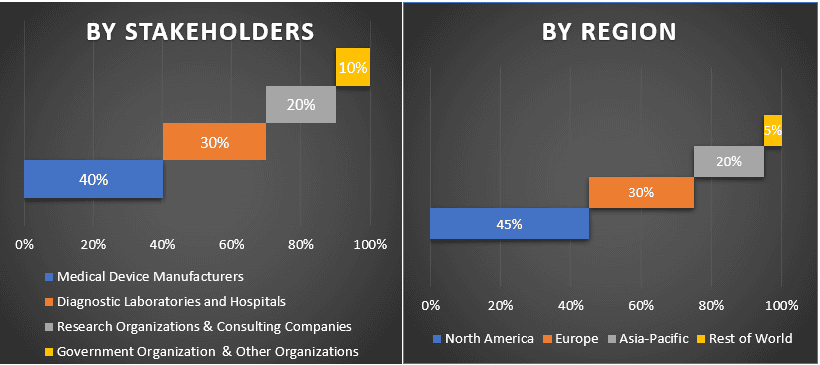
市场工程
采用数据三角测量技术来完成整体市场估算,并得出自动化微生物学市场各细分市场和子细分市场的精确统计数据。在研究了自动化微生物学市场在技术和最终用户领域的各种参数和趋势后,将数据细分为几个细分市场和子细分市场。
自动化微生物学市场研究的主要目标
研究确定了自动化微生物学的当前和未来市场趋势。投资者可以从研究中进行的定性和定量分析中获得战略见解,以作为其投资的依据。确定当前和未来的市场趋势,以确定市场在区域层面的整体吸引力,为行业参与者提供了一个平台,以利用未开发的市场,从而获得先发优势。研究的其他定量目标包括:
- 按价值(美元)分析自动化微生物学的当前和预测市场规模。此外,分析不同细分市场和子细分市场的当前和预测市场规模
- 研究中的细分市场包括技术和最终用户领域
- 定义和分析自动化微生物学行业的监管框架
- 分析涉及各种中介机构的价值链,以及分析行业的客户和竞争对手行为
- 分析主要地区的自动化微生物学市场的当前和预测市场规模
- 报告中研究的主要地区包括北美、欧洲、亚太地区和世界其他地区
- 自动化微生物学市场的公司概况以及市场参与者为在快速增长的市场中保持生存而采取的增长策略
- 对行业的深入区域级分析
相关 报告
购买此商品的客户也购买了


